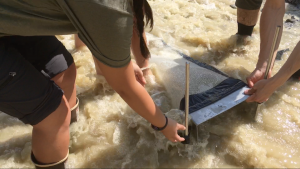Forschung
Forschungsthemen
Die Geographien industrieller Dynamiken
Ökonomische Aktivität ist räumlich ungleich verteilt. Der Forschungsschwerpunkt setzt zur Erklärung dieser ungleichen Entwicklung industrielle Dynamiken in den Fokus. Industrielle Dynamiken umfassen die Veränderungen von Technologien, Märkten, Produkten und Unternehmen in arbeitsteiligen Systemen. Diese Veränderungen führen zu spezifischen räumlichen Ausprägungen von Industrien. Aktuelle Forschungsfelder reichen von der Windturbinenindustrie hin zu Kunstmärkten.
Dieses Forschungsthema steht im Zusammenhang mit den Forschungsclustern Nachhaltigkeit sowie Energiemanagement und -technik der Universität.
Kontakt: Univ.-Prof. Dr. Max-Peter Menzel
Kritische Stadt- und Regionalforschung
Der Forschungsbereich nutzt Ansätze der Kritischen Geographie für die Untersuchung räumlicher Ungleichheiten, Konflikte, aber auch von Alternativen und Utopien urbaner und regionaler Entwicklung. Aktuelle Arbeitsschwerpunkte umfassen die Transformationen städtischer und ländlicher Räume, technische und soziale Infrastrukturen, Auswirkungen der Finanzialisierung, Veränderungen auf dem Wohnungsmarkt sowie Fragen politischer Mobilisierung und kollektiver Erinnerung.
Dieses Forschungsthema steht im Zusammenhang mit dem Forschungscluster Nachhaltigkeit der Universität.
An den Arbeiten zu diesem Forschungsthema sind folgende Mitarbeiter*innen beteiligt: PhhD Studentin Felicitas Kübler
Geographiedidaktik
Im Fokus der Geographiedidaktik als spezielle Fachdidaktik und Wissenschaft steht inhaltlich das kompetenzorientierte Lehren und Lernen geographischer und sozioökonomischer Sachverhalte innerhalb und außerhalb der Schule. Gegenstand geographiedidaktischer Forschung ist u.a. die empirische Gewinnung von intersubjektiv überprüfbaren Erkenntnissen über die Voraussetzungen, die Ziele und Relevanzen, die Prozesse und Instrumente sowie die Folgen des geographischen Lernens und Lehrens im GW-Unterricht.
Dieses Forschungsthema steht im Zusammenhang mit dem Forschungscluster Bildungsforschung der Universität.
Kontakt: Dr. Myriam Albrecht und Dr. Horst Kanzian.
Mensch-Umwelt-Forschung aus physisch-geographischer Perspektive
Die derzeitigen Wechselwirkungen zwischen Mensch und natürlicher Umwelt erhöhen die Komplexität der Ökosysteme. Daher ist es unser Ziel, wichtige empirische und modellierende Beiträge in der Wechselwirkung zwischen menschlicher und natürlicher Umwelt zu leisten, mit einem besonderen Schwerpunkt auf drei stark interdisziplinär ausgerichteten Forschungsfeldern, die in die integrative Geographie eingebettet sind, nämlich Terrestrische Ökohydrologie, Umweltgesundheit mit Schwerpunkt Boden, Resilienz – Systemwissenschaftliche Anwendungen und Kreiswirtschaft/Circular Economy.
Wasserverfügbarkeit, -nutzung und -verteilung in der Landschaft
This research played an important part in advancing understanding of terrestrial hydrology in montane areas in La Gomera island (Spain), where the national park of Garajonay protects the laurisilva forest and in mountain forest areas in Renon, South Tyrol (Italy). We have developed an appreciation for the importance of the fog, rainfall and throughfall dynamics and their spatial variability at catchment level for the soil water balance, of net precipitation dynamics (modelling), of the stand soil water use (transpiration and canopy conductance dynamics modelling) and of the soil water repellency. Main findings of this research are published within a PhD thesis book (extract in ResearchGate) and high-ranking journal publications. In addition, both study areas are also integrated in our teaching courses.
Collaborations:
Research in La Gomera is conducted together with the National Park, the water council and University of Kiel (Germany).
Current research in South Tyrol is conducted together with University of Bozen, ETH-Zurich and University of Münster.
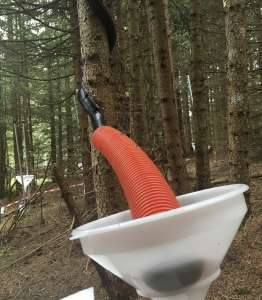
Throughfall and stemflow measurement
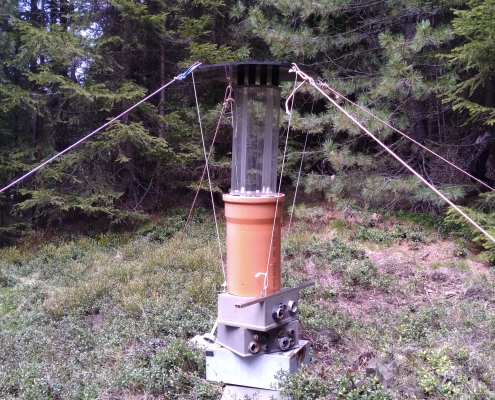
Fog collector
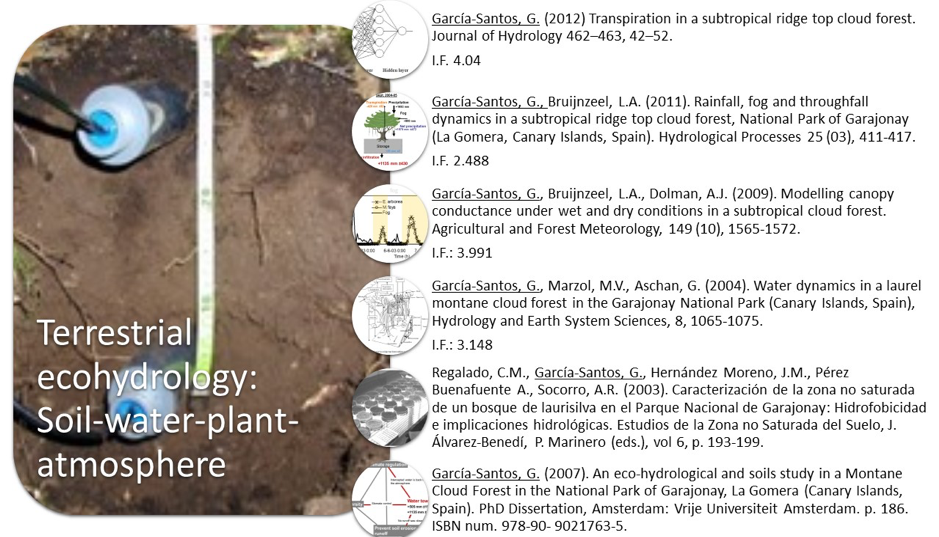
Terrestrial ecohydrology: Soil-water-plant atmosphere
Publications:
García-Santos, G. (2012) Transpiration in a subtropical ridge top cloud forest. Journal of Hydrology 462–463,42–52.
I.F. 4.04
García-Santos, G., Bruijnzeel, L.A. (2011): Rainfall, fog and throughfall dynamics in a subtropical ridge top cloud forest, National Park of Garajonay (La Gomera, Canary Islands, Spain). Hydrological Processes 25 (03), 411-417.
I.F. 2.488
García-Santos, G., Bruijnzeel, L.A., Dolman, A.J. (2009). Modelling canopy conductance under wet and dry conditions in a subtropical cloud forest. Agricultural and Forest Meteorology, 149 (10), 1565-1572.
I.F.: 3.991
García-Santos, G., Marzol, M.V., Aschan, G. (2004). Water dynamics in a laurel montane cloud forest in the Garajonay National Park (Canary Islands, Spain), Hydrology and Earth System Sciences, 8, 1065-1075.
I.F.: 3.148
Regalado, C.M., García-Santos, G., Hernández Moreno, J.M., Pérez Buenafuente A., Socorro, A.R. (2003). Caracterización de la zona no saturada de un bosque de laurisilva en el Parque Nacional de Garajonay: Hidrofobicidad e implicaciones hidrológicas. Estudios de la Zona no Saturada del Suelo, J. Álvarez-Benedí, P. Marinero (eds.), vol 6, p. 193-199.
García-Santos, G. (2007). An eco-hydrological and soils study in a Montane Cloud Forest in the National Park of Garajonay, La Gomera (Canary Islands, Spain). PhD Dissertation, Amsterdam: Vrije Universiteit Amsterdam. p. 186. ISBN num. 978-90- 9021763-5.
Landnutzungsänderungen und Auswirkungen auf die Landschaft - Umweltgesundheit
This research plays an important part in advancing understanding of the fate of harmful substances applied with hand-held sprayers, commonly used to control pests in mountainous areas in the Andean Region, where farmers and family members suffer health problems derived from the use of agrochemicals. We developed an appreciation for the importance of drift, which is the flow of pesticides from the applied field going out to the nearby sites, deposited on the body of the applicator and bystanders, the influence of meteorological conditions during pesticide applications and the role of protective equipment to reduce human and environmental exposure.
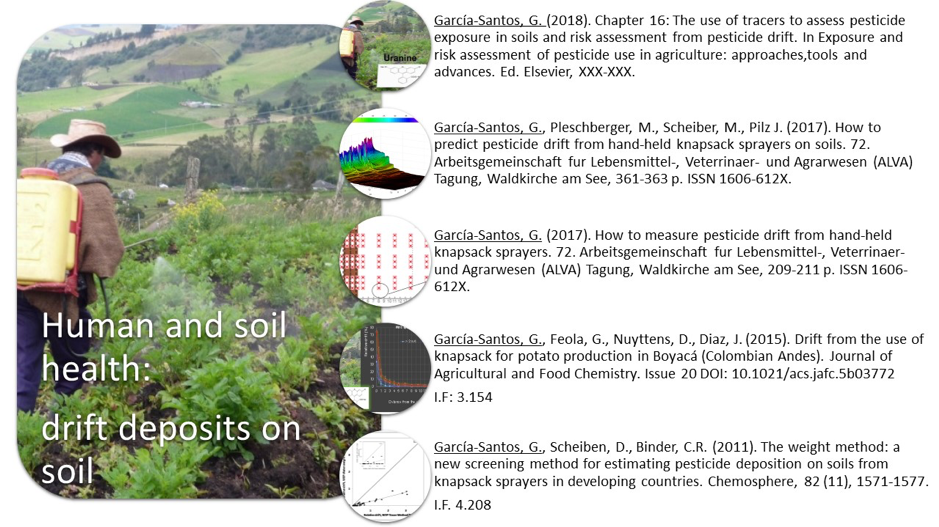
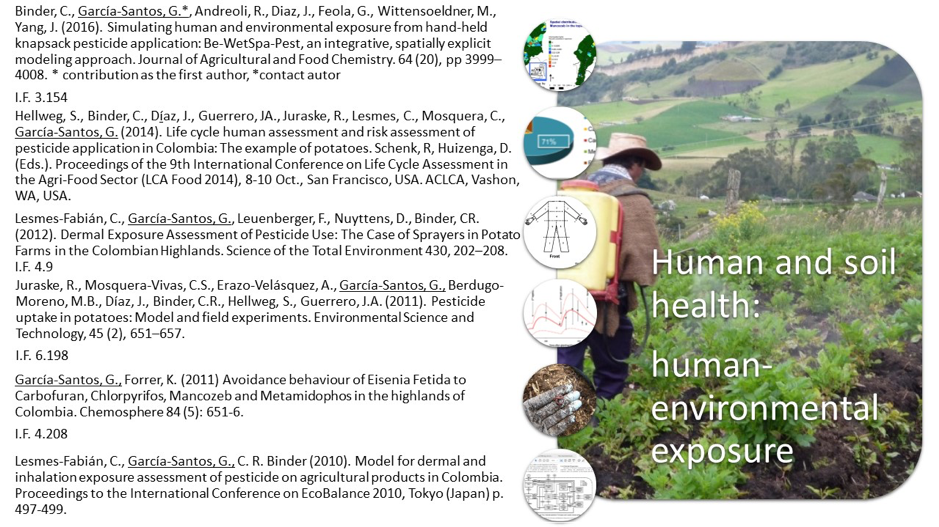
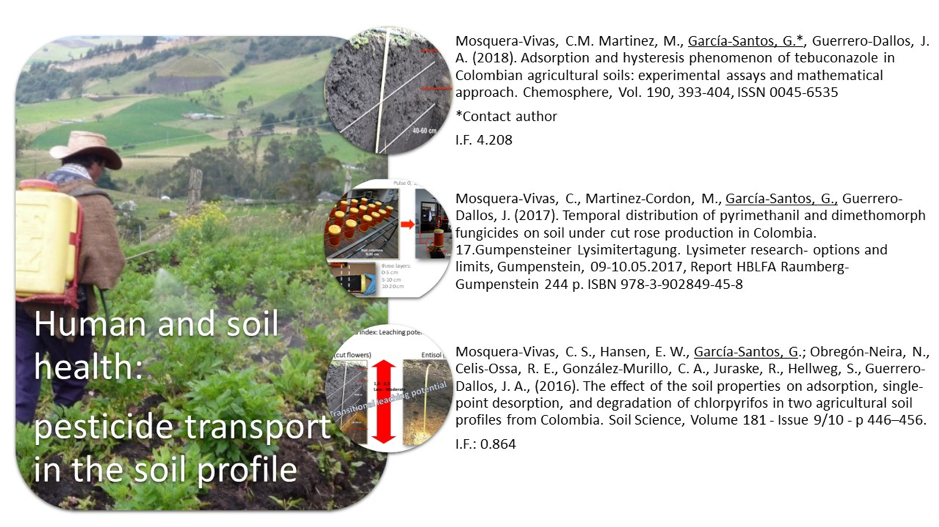
Human and soil health: drift deposits on soil
Publications:
García-Santos, G., Schreiber, M., Pilz, J. (2020) Spatial interpolation methods to predict airbone pesticide drift deposits on soil using handheld sprayers. Chemosphere Vol. 258, 127231. DOI: https://doi.org/10.1016/j.chemosphere.2020.127231
I.F. 5.1
García-Santos, G., Pleschberger, M., Scheiber, M., Pilz J. (2017). How to predict pesticide drift from hand-held knapsack sprayers on soils. 72. Arbeitsgemeinschaft für Lebensmittel-, Veterrinär- und Agrarwesen (ALVA) Tagung, Waldkirche am See, 361-363 p. ISSN 1606-612X.
García-Santos, G. (2017). How to measure pesticide drift from hand-held knapsack sprayers. 72. Arbeitsgemeinschaft für Lebensmittel-, Veterrinär- und Agrarwesen (ALVA) Tagung, Waldkirche am See, 209-211 p. ISSN 1606-612X.
García-Santos, G., Feola, G., Nuyttens, D., Diaz, J. (2015). Pesticide drift from the use of knapsack for potato production in Boyacá (Colombian Andes). Journal of Agricultural and Food Chemistry. DOI: 10.1021/acs.jafc.5b03772
I.F: 3.154
García-Santos, G., Scheiben, D., Binder, C.R. (2011). The weight method: a new screening method for estimating pesticide deposition from knapsack sprayers in developing countries. Chemosphere, 82 (11), 1571-1577.
I.F. 4.208
Human and soil health: human-environmental exposure
Publications:
23.04.2024 EGU24-10943 Posterpräsentation: Study about perception of soils compaction in grasslands: what can be learnt to foster sustainability and policy intervention? EGU-Generalversammlung 2020, Wien, Österreich.
20.04.2024 EGU24-19602 P Posterpräsentation: Influence of soil moisture content on water repellency after a forest burnt. EGU-Generalversammlung 2020, Wien, Österreich.
25.04.2023 EGU23-11647 Posterpräsentation: Preliminary study about soil compaction and awareness in grasslands in Carinthia (south Austria), EGU-Generalversammlung 2023, Wien, Österreich, 24.–28. April 2023, EGU23-11647
Mosquera-Vivas, C. S., Celis-Ossa, R. E., González-Murillo, C. A., Obregón-Neira, N., Martínez-Cordón M. J., Guerrero-Dallos, J. A., García-Santos, G. (2023). Empirical Model to assess leaching of pesticides in soil under a steady-state flow and tropical conditions. International Journal of Environmental Science and Technology https://doi.org/10.1007/s13762-023-05038-w I.F.: 6.198
García-Santos, G. (2021). Review: Use of tracers to assess pesticide drift exposure in soil and human. In Exposure and Risk Assessment of Pesticide Use in Agriculture: Approaches, Tools and Advances. Elsevier. 412 p. DOI: 10.1016/b978-0-12-812466-6.00003-8 ISBN 978-0-12-812466-6
Binder, C., García-Santos, G.*, Andreoli, R., Diaz, J., Feola, G., Wittensoeldner, M., Yang, J. (2016). Simulating human and environmental exposure from hand-held knapsack pesticide application: Be-WetSpa-Pest, an integrative, spatially explicit modeling approach. Accepted by Journal of Agricultural and Food Chemistry. 64 (20), pp 3999–4008. *contribution as the first author, * contact author
I.F. 3.154
Hellweg, S., Binder, C., Díaz, J., Guerrero, JA., Juraske, R., Lesmes, C., Mosquera, C., García-Santos, G. (2014). Life cycle human assessment and risk assessment of pesticide application in Colombia: The example of potatoes. Schenk, R, Huizenga, D. (Eds.). Proceedings of the 9th International Conference on Life Cycle Assessment in the Agri-Food Sector (LCA Food 2014), 8-10 October 2014, San Francisco, USA. ACLCA, Vashon, WA, USA.
Lesmes-Fabián, C., García-Santos, G., Leuenberger, F., Nuyttens, D., Binder, CR. (2012). Dermal Exposure Assessment of Pesticide Use: The Case of Sprayers in Potato Farms in the Colombian Highlands. Science of the Total Environment 430, 202–208.
I.F. 4.9
Juraske, R., Mosquera-Vivas, C.S., Erazo-Velásquez, A., García-Santos, G., Berdugo-Moreno, M.B., Díaz, J., Binder, C.R., Hellweg, S., Guerrero, J.A. (2011). Pesticide uptake in potatoes: Model and field experiments. Environmental Science and Technology, 45 (2), 651–657.
I.F. 6.198
García-Santos, G., Forrer, K. (2011) Avoidance behaviour of Eisenia Fetida to Carbofuran, Chlorpyrifos, Mancozeb and Metamidophos in the highlands of Colombia. Chemosphere 84 (5): 651-6.
I.F. 4.208
Lesmes-Fabián, C., García-Santos, G., C. R. Binder (2010). Model for dermal and inhalation exposure assessment of pesticide on agricultural products in Colombia. Proceedings to the International Conference on EcoBalance 2010, Tokyo (Japan) p. 497-499.
Human and soil health: pesticide transport in the soil profile
Publications:
Mosquera-Vivas, C.M. Martinez, M., García-Santos, G.*, Guerrero-Dallos, J.A. (2018). Adsorption and hysteresis phenomenon of tebuconazole in Colombian agricultural soils: experimental assays and mathematical approach. Chemosphere 190: 393-404. ISSN 0045-6535
*Contact author
I.F. 4.208
Mosquera-Vivas, C., Martinez-Cordon, M., García-Santos, G., Guerrero-Dallos, J. (2017). Temporal distribution of pyrimethanil and dimethomorph fungicides on soil under cut rose production in Colombia. 17.Gumpensteiner Lysimitertagung. Lysimeter research- options and limits, Gumpenstein, 09-10.05.2017, Report HBLFA Raumberg-Gumpenstein 244 p. ISBN 978-3-902849-45-8
Mosquera-Vivas, C. S., Hansen, E. W., García-Santos, G.; Obregón-Neira, N., Celis-Ossa, R. E., González-Murillo, C. A., Juraske, R., Hellweg, S., Guerrero-Dallos, J. A., (2016). The effect of the soil properties on adsorption, single-point desorption, and degradation of chlorpyrifos in two agricultural soil profiles from Colombia. Soil Science. Sep./Oct. 2016 – Volume 181 – Issue 9/10 – p 446–456.
I.F.: 0.864
Wasserlandschaft, Mensch-Natursysteme und Nachhaltigkeit
This research plays an important part in advancing understanding of socio-hydrology like for example hydrological processes and contamination issues in coupled systems of human actors and ecosystems. Resilience of water management is a current research topic being conducted in Spain and is taught in different courses at Master level. We develop an analytical dynamic model to predict scenarios of changes in canopy structure on soil moisture considering not only physical indicators but anthropogenic activities, like induced fires. We hope to be able to model key feedback mechanisms resulting on loss of vegetation, in coupled systems of human actors and ecosystems over different space and time scales.
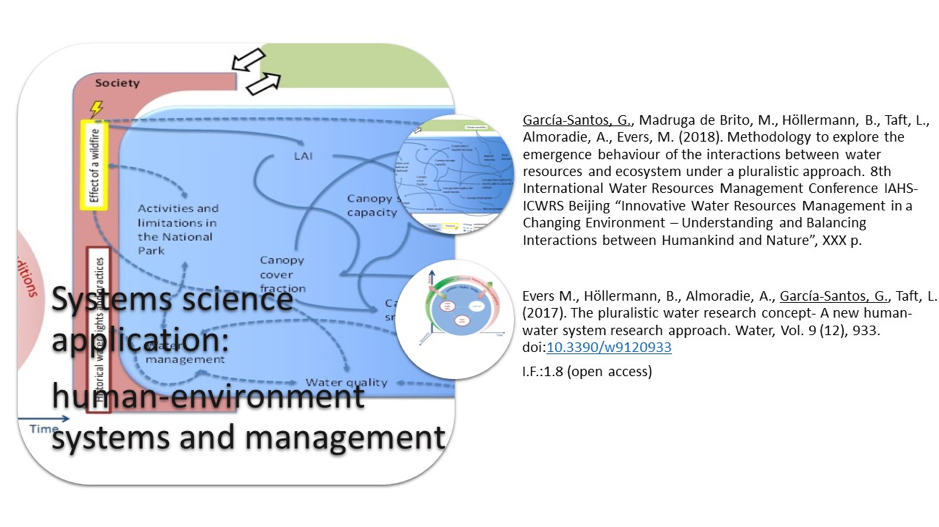
Publications:
New conceptual approaches, which integrates perspectives from hydrology, social sciences, and policy analysis to develop comprehensive water management strategies:
Yu, D.J., Haeffner, M., Jeong, H., Pande, S., Dame, J., Di Baldassarre, G., Garcia-Santos, G., Hermans, L., Muneepeerakul, R., Nardi, F. and Sanderson, M.R., (2022). On capturing human agency and methodological interdisciplinarity in socio-hydrology research. Hydrological Sciences Journal, pp.1-12. https://doi.org/10.1080/02626667.2022.2114836
I.F.: 2.8 IF; 3.9 5-year IF, Q1
New methodology to explore the emergence behaviour of the interactions between water resources and ecosystem under a pluralistic approach. This publication was published in a journal with low impact factor but it presents a new exploratory methodology, which helps identify feedback loops and emergent behaviors in socio-ecological systems, such as those observed in forest ecosystems or agricultural landscapes.
García-Santos, G., Madruga de Brito, M., Höllermann, B., Taft, L., Almoradie, A., Evers, M. (2018). Methodology to explore the emergence behaviour of the interactions between water resources and ecosystem under a pluralistic approach. Copernicus Publications, Proceedings of IAHS (PIAHS), 379, 83-87, 2018. https://doi.org/10.5194/piahs-379-83-2018
I.F.: 1.6 (Scopus)
Evers, M., Höllermann, B., Almoradie, A., García-Santos, G., Taft, L. (2017): The pluralistic water research concept – A new human-water system research approach. Water, Vol. 9 (12), 933.
doi:10.3390/w9120933
I.F.:1.8 (open access)
Dieses Forschungsthema steht im Zusammenhang mit den Forschungsclustern Selbstorganisierende Systeme und Nachhaltigkeit der Universität.
Kontakt: Assoc. Prof. Dr. Glenda Garcia-Santos
Geographische Datenwissenschaft und deren Anwendung
Geographische Datenwissenschaft ist ein neuer Fachbereich in der Geoinformationsverarbeitung, in dem mit althergebrachten multivariaten Methoden und des Data-Minings für Big Data sowie den neuesten Methoden der Künstlichen Intelligenz und des Maschinellen Lernens geographische Modelle erstellt und angewandt werden. Die Forschungen liegen sowohl in der Methodenentwicklung als auch in der Implementierung und Anwendung derselben. Die Arbeitsgruppe befasst sich konkret mit der Modellierung der Potenziale erneuerbarer Energieträger, Digitaler Bildverarbeitung von Satellitendaten, Agentenbasierter Modellierung und der Vorhersage und Szenarienerstellung von Strukturen und Prozessen in unterschiedlichen Geosystemen.
Dieses Forschungsthema steht im Zusammenhang mit den Forschungsclustern Energiemanagement und -technik sowie Selbstorganisierende Systeme der Universität.
Kontakt: Ass.-Prof. Dr. Peter Mandl
Eine vollständige Liste aller Forschungsprojekte des Instituts für Geographie und Regionalforschung finden Sie in der Forschungsdokumentation (FoDok).
Quicklinks
Plattformen

Informationen für
Adresse
Universitätsstraße 65-67
9020 Klagenfurt am Wörthersee
Austria
+43 463 2700
uni [at] aau [dot] at
www.aau.at
Campus Plan
Anreise











